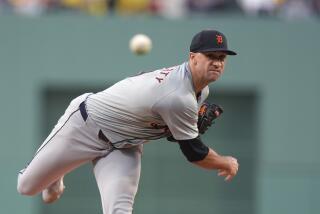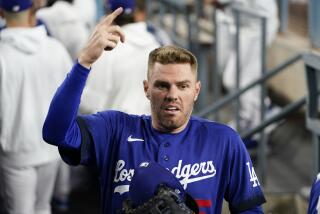Numbers Don’t Lie on Jefferies
- Share via
The subject for today is “What’s So Smart About Baseball?” Part IV.
Every time I see Gregory Scott Jefferies in the uniform of the St. Louis Cardinals, I feel like cracking myself on the side of the head. Or getting my eye checked.
It’s a puzzlement, as the king of Siam would say. Only two years ago, Gregg was in the uniform of the Kansas City Royals. Before that, he was in the livery of the New York Mets.
Now usually, when a guy sets sail through the majors like that, he is a marginal player. Trade bait. Stuck in the window with a price tag or a “Make offer” label. Or even “Marked down. Priced to move.”
You figure the guy can’t hit the curveball or strikes out a lot. Sometimes, he’s just a clubhouse lawyer, a malcontent or chronically injured. “Have .220 average, will travel.”
Jefferies is none of the above. He is an elite player, if you go by the numbers that baseball, the decimal capital of the world, always does. His manager, Joe Torre, says he is one of the best hitters in the game. He doesn’t have a weakness.
Consider the numbers: Last year, Andres Galarraga was the batting champion of the National League with a .370 average. San Diego’s Tony Gwynn was second at .358. Gregg Jefferies was third at .342.
But, under the old rules, which specified that a batsman must have 500 official at-bats to qualify for the championship, only Jefferies, with 544, would have qualified.
The rule was changed in the mid-’50s after Ted Williams had batted .345 one year, only to see Bobby Avila named champion with .341. The next year, Williams hit .356, only to see Al Kaline crowned champ with .340. The problem was, ol’ Teddy Ballgame was being walked so much he couldn’t compile the required at-bats.
The rule was changed to qualify a champion if he made 500 appearances at the plate, regardless of whether he walked, hit sacrifice flies or got hit by pitches. It was just in time. Williams batted .388 the next year. Baseball would have been embarrassed to make him a loser with that kind of an average.
Jefferies, though, is not interested in technicalities.
“It’s an honor just to be mentioned in the same breath as Tony Gwynn,” he said earnestly the other night at Dodger Stadium.
Jefferies, of course, should still be in a Met uniform. The Mets don’t have too many people mentioned in the same breath as Tony Gwynn.
To be sure, they traded him to Kansas City for a Cy Young Award-winning pitcher, Bret Saberhagen. There is a rule of thumb in baseball, if you trade daringly, trade for a pitcher.
But it doesn’t always work. Saberhagen with New York the last two seasons was 3-5, 7-7. He is 6-2 this season, but even that isn’t Cy Young stuff. Young Master Jefferies, meanwhile, hit .285 in his year with K.C.
It was not the first time trading for a pitcher backfired. The Cincinnati Reds once traded Frank Robinson, no less, for pitcher Milt Pappas. They gave the Baltimore Orioles several pennants and World Series.
The Chicago Cubs topped that, though. They traded once for pitcher Ernie Broglio. They gave the Cardinals Lou Brock for him. You’ll find Brock listed as the all-time National League base-stealer with 938 thefts. That Lou Brock. Broglio won 14 and lost 31 for the Cubs. That Ernie Broglio.
The Cardinals got Orlando Cepeda for pitcher Ray Sadecki. Cepeda had Hall of Fame abilities. Sadecki had American Assn. abilities.
Any trade is a crapshoot. Or a shot in your foot. But putting a player of Jefferies’ stature on the counter is courting front-office disaster. Reputations are ruined. You tend to get remembered for serious blunders. They make better copy than successes or trades that were standoffs. That Nirvana of the trading block--the trade that helps both clubs, rarely materializes. More likely is the trade that helps neither club. Or, that dread of the general manager, the trade that returns to haunt you.
It’s hard to see what the game wants out of Jefferies. At New York, the vets were annoyed by him because he:
--Showed up for work.
--Tried hard.
--Took defeat personally.
--Hit .276.
You can see where that would tick off a guy getting $2 million a year for doing none of the above--at least not every day.
But when Kansas City traded him, it was for Felix Jose, a player so little known that most people think he wears his name backward. Jose hit .253 last year. Jefferies was almost 100 points higher. Power? Jose had six home runs, Jefferies 16. Speed? Jose had 31 stolen bases, Jefferies 46.
“Jefferies gives us exactly what we want,” says Torre. “He’s aggressive at the plate and on the bases. He’s a switch-hitter, so you can’t change pitchers on him, and he’s equally able from either side.
“Besides, he’s a throwback. He manages to get dirty even on the AstroTurf fields. Some guys wouldn’t get dirty in a mud bath, but he’d get dirty in a hotel lobby. Certainly by the third inning, he looks like one of the old Gas House Gang Cardinals.”
Even Jefferies was surprised when the Royals put him on the block.
“Of course, I had gone to arbitration,” he said. “But when the rumors came up, even George Brett scoffed. ‘They’ll never trade a good hitter like you--who’d they get?’ he told me. Two days later I was gone.”
At the close of business Saturday, Gregg Jefferies was batting a robust .328 with five home runs, 12 doubles, 20 runs and six steals. And a dirty uniform.
It’s not likely the Cardinals will trade him. But that doesn’t mean he won’t move. The general manager who might relocate him is Gregg Jefferies. He becomes a free agent next year. Jefferies might put Jefferies on the road again.
“I was a huge Dodger fan growing up,” he says. “But they’re pretty well set at first base.”
The Mets got a Cy Young pitcher for him. The Royals got a guy with two first names. What will Jefferies get for him? Probably a no-trade contract--and a sign to put up over his locker: “Even Babe Ruth Got Traded.”
Baseball never learns.
More to Read
Go beyond the scoreboard
Get the latest on L.A.'s teams in the daily Sports Report newsletter.
You may occasionally receive promotional content from the Los Angeles Times.










